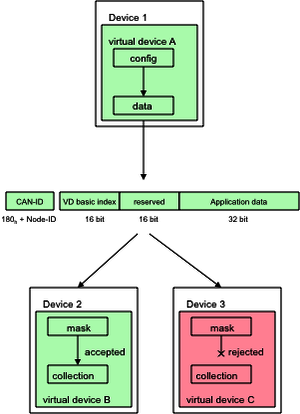CiA® 416 series: CANopen application profile for building door control

accepted/rejected according to local object mask
The profile specifies the CANopen interaction for automatic building door control sub-systems, such as door locking status, key cylinders, handles, alarms, system parameters, and keypads. Each of these functions is specified as a virtual device (VD).
The application profile includes three parts:
- Part 1: General definitions, start-up procedures, and system security
- Part 2: Virtual devices overview
- Part 3: Pre-defined communication objects and application data objects
A physical CANopen device consists of one or more freely combinable VDs. Each VD supports a set of mandatory objects and may implement additional optional objects. Each physical CANopen device includes the first pre-defined TPDO (transmit process data object) with a specified mapping structure. Among other things, the first TPDO contains the VD basic index, which indicates which VD has sent the data. All networked devices receive the first TPDO from each other device. An object mask determines whether the data contents need to be processed. Relevant data is stored in the VD's collection object array.
Each VD covers an index range of eight objects, with the first four objects having the same structure. The first object contains the application data sent via TPDO. The index of the first object (VD basic index) identifies the virtual device. The second object is a collection array for storing relevant data received from other devices. The third object is a mask array indicating whether the received data is relevant for the application. The fourth object contains configuration data for the VD.
The application profile specifies two start-up behaviors: with ACP (address claiming procedure) active or inactive. In the first case, the device receives its node-ID through the address claiming procedure. In the second case, the device uses a pre-configured node-ID. At system start-up, all devices normally have the same setting (ACP active or inactive).
Each device may be assigned to a group (Group 1, Group 2, no group, or both). During the ACP, each device claims its node-ID and informs other nodes about its group membership. The receivers of the claiming message use this information to set up their object masks. A device only processes data sent by devices in the same group.
Activating data encryption and decryption increases system security. A new device cannot be added to a network that is already "configured." To prevent unauthorized changes to object data, access to the object dictionary is password-protected. Additionally, to avoid eavesdropping and manipulation of PDO data, PDO communication can be encrypted.
The CAN CC physical layer is based on ISO 11898-2. In addition to the bus-line topology, the network can also be implemented using a combined star and tree topology. Each compliant device should use a 24-V power supply. The default bit rate is 125 kbit/s with bit timing as specified in CiA 301 v. 4.2.0 (CANopen CC). It is recommended to use connectors with a pin assignment, as given in CiA 890.
| Title | Details | Published Size |
Status Action |
|---|---|---|---|
|
|
ScopeThis specification specifies the CANopen application layer. This includes the data types, encoding rules and object dictionary objects as well as the CANopen communication services and protocols. In addition, this specification specifies the CANopen network management services and protocols. This specification specifies the CANopen communication profile, e.g. the physical layer, the pre- defined communication object identifier connection set, and the content of the Emergency, Time- stamp, and Sync communication objects. |
2011-02-21 3 MB | PAS Login |
|
|
ScopeThe CANopen application profile for building door control consists of several parts: • Part 1: General definitions, start-up procedures and system security; • Part 2: Virtual devices overview; • Part 3: Pre-defined communication objects and application object specification. These specifications represent the CANopen application profile for building door control. It describes the interaction of e.g. door locking status, key cylinder, handle, alarms, system parameters, keypads and many more. Each of those properties is realized as a single virtual device. |
2007-08-28 670 KB | DSP Login |
|
|
ScopeThis part of the application profile gives an overview of the virtual devices. |
2007-08-28 361 KB | DSP Login |
|
|
ScopeThis part of the application profile pre-defines the application objects of the physical and virtual devices in detail. |
2007-08-28 4 MB | DSP Login |
|
|
ScopeThis document provides recommendation how to represent the international system of units and prefixes in parameter specifications. It recommends also the structure of configuration parameters for SI units and prefixes. |
2023-01-10 267 KB | TR Login |